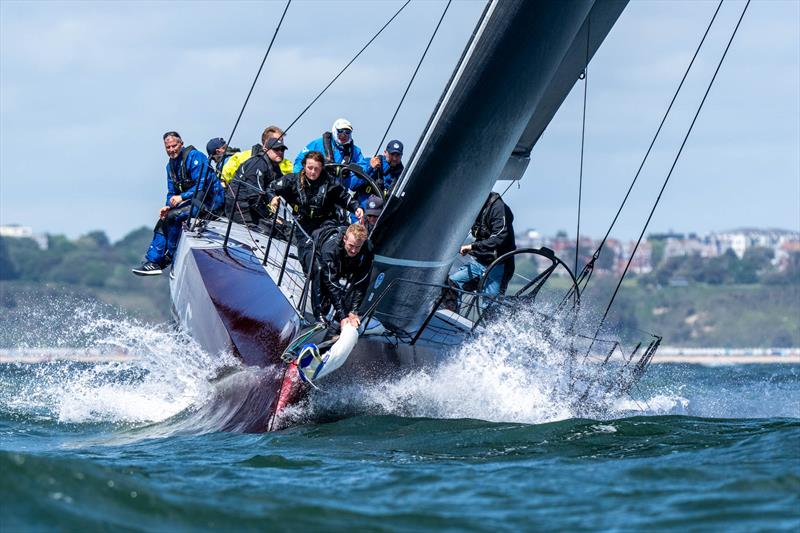
Complex, Controlled Coordination
by Mark Jardine 30 May 2024 03:00 AEST

2024 International Paint Poole Regatta © Ian Roman / International Paint Poole Regatta
The International Paint Poole Regatta over the late May Bank Holiday long weekend in the UK was a superb yacht racing event.
Poole Harbour is the second largest natural harbour in the world (Sydney Harbour is the biggest), but only one of the five race courses was held there, with four in Poole Bay, which has some of the most stunning backdrops you could wish for. On its day, it's a bucket-list venue, and the whole 2024 event was just that.
Eight races were scheduled over the three days, and that's exactly the number completed. A light to moderate start, a properly breeze middle day, and a moderate to fresh conclusion, all under sunshine in pleasant temperatures made for the kind of sailing event you wish for. Things don't always go as you'd like at sailing events, so you have to savour it when they do.
Reporting on the event, I was driving a 5.5m RIB with top sailing photographer Ian Roman. My role was to get him in the right position to get the shots he wanted, while keeping his cameras dry. Ian knows the composition he wants for each shot, and we discussed at length how we were going to approach each situation and what he wanted in the background. We then factored in exit routes in case we found a yacht aiming straight for us, and how we'd stay out of their racing lines and minimise our wash.
With us both being regular sailors, we could gauge the start line bias, lay lines and approximately when people were going to bear away, but it isn't 100%, so having contingency plans was essential, and sometimes necessary to utilise. It was great fun, another superb learning experience, and again I was amazed at how much you learn about sailing when not actually being aboard a yacht.
I'm a firm believer that every helm should spend time on the bow to really understand what happens during manoeuvres. It's all very well, and not at all useful, for the afterguard to shout 'get the kite down' when things are going wrong on a drop.
When there are problems it's vital that the helm positions the boat at the best angle to help for foredeck crew clear up the mess. Simply covering the spinnaker with the mainsail can take all the weight out of it, making the job of those who are doing the work much easier.
The communication and coordination on a yacht team is crucial to success. Starting well in a race is always key, and tactically big gains can be made by using the wind shifts and tide to your advantage. Good boat speed will gain you a bit, but most of the top teams will be sailing their boats fast, so the gains are minimal. Executing manoeuvres can make or break a race, with a poor leeward mark having the potential to change a race-winning position into a bad race.
What was so noticeable on the top yachts was that there was one person making the crew coordination calls, and they certainly weren't the helmsman or tactician. They clearly gave a countdown to the spinnaker hoists and drops and they were on the lookout for potential problems, giving instructions to the afterguard when a situation arose.
When the helm got involved in the instructions during a situation, things invariably went from bad to worse. If a gybe hasn't gone smoothly, then going from a run to a reach before the problem is resolved is going to end in tears and witnessing it from off the boat is almost like watching a car crash in slow motion. You can see what needs to be done to resolve the issue and can't help but wince when the opposite happens, and the mess is exacerbated.
Yacht racing is a team sport, and can be complex, so understanding what is needed when can make a massive difference, and in the process save a huge amount of money and aggravation if damage is avoided. In addition, a calm and coordinated crew will invariably enjoy their sailing and want to come back for more. It's a win-win.
It's not just the sailing crews who need to work in perfect harmony. With five race course areas and a host of mark-laying boats, coordinating the race management is no easy task. This was an area Ian and I simply looked on and marvelled. We couldn't suggest changes, we didn't wince as we watched on, as the complexities of it all were all handled seamlessly.
I take my hat off to the combined clubs' team who run the International Paint Poole Regatta - they ran the event flawlessly. I have to scratch my head enough when I'm running a club race with 30 competitors, so witnessing the management of this scale of event, and seeing the choreography play out like a West End musical, is a sight to behold.
Whatever your role in sailing, complex, controlled coordination takes preparation. Make sure everyone knows their roles, define who is making the calls, and understand what to do when things go wrong. Put this all together and you'll have far more enjoyment when out on the water.
Mark Jardine
Sail-World.com and YachtsandYachting.com Managing Editor